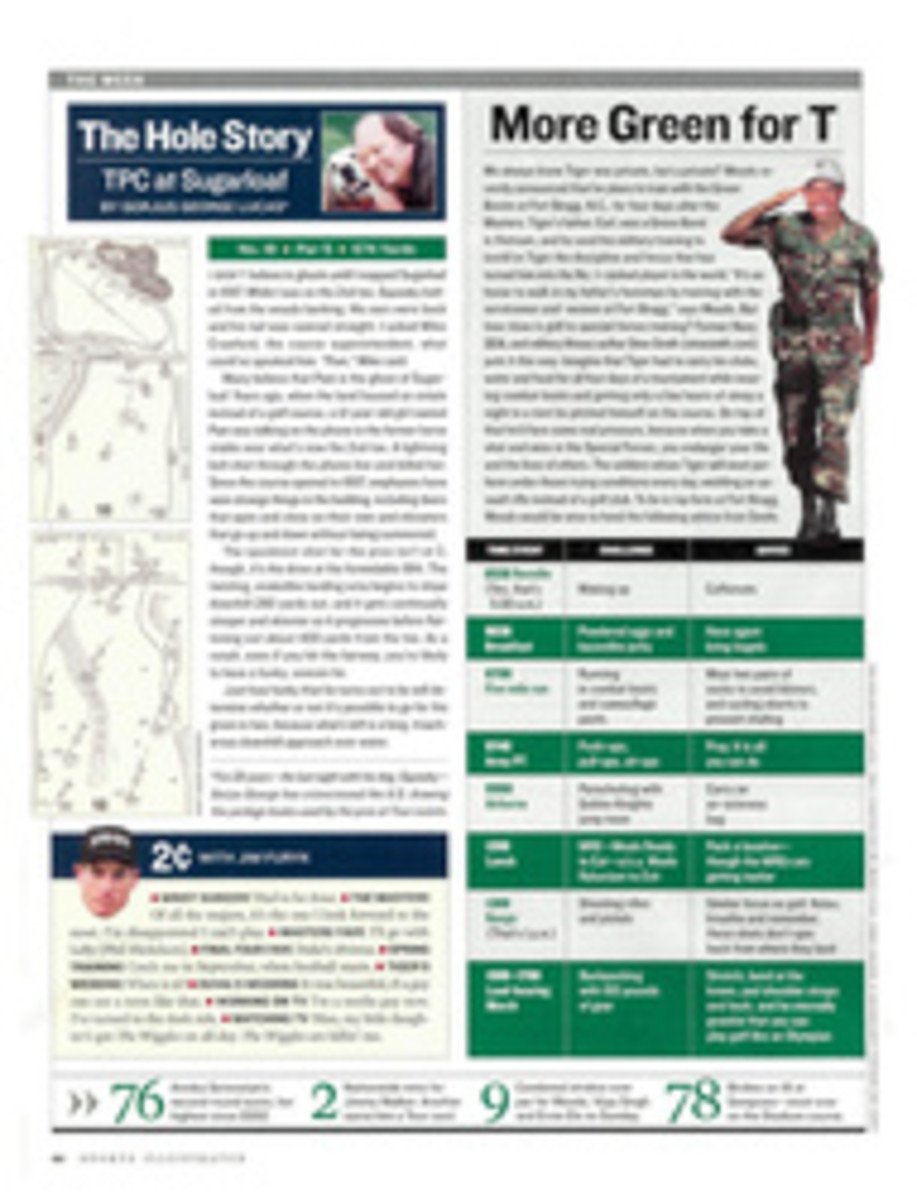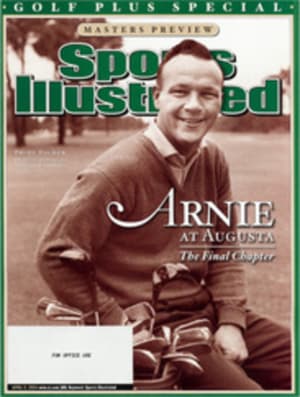
War Stories During an impromptu detour, the author ends up awakening some unsettling 40-year-old memories
It may have simply been the light when I first saw the place at
dusk after nearly 40 years, the light like the silvery pearl hollow
of a shell. But when I turned onto Fort Benning Road and saw the
old, familiar sign at the entrance--WELCOME TO FORT BENNING/U.S.
ARMY MILITARY RESERVATION--I felt a touch of sorrow at the sight, a
sadness that went beyond nostalgia. I pulled off the road and sat
there for a while, swimming around in those little spring-fed pools
of my past, until finally I turned and glanced behind me up Fort
Benning Road and saw Mathews Street climbing up a steep hill toward
Ticknor Drive, to where our apartment used to be. But I did not
want to go there yet.
For the last three weeks, since tossing my golf clubs into the
trunk of my rented Buick in Washington, D.C., I had been thumping
balls from Rocky Mount, N.C., down through western Georgia,
aimlessly meandering my way south and looking to play golf right
into Florida. Two days after a glorious afternoon at Osprey Point,
on Kiawah Island, S.C. (GOLF PLUS, March 23), I was chased and
mauled by that unrivaled bitch-goddess of American golf, the Ocean
course on Kiawah--scene of the 1991 Ryder Cup and among the world's
toughest courses. In fact, we were heading up the 18th fairway,
into the wind and rain, with the surf doing somersaults on the
beach, when a Kiawah Resort official, Michael Vegis, muttered
grimly, "You are now seeing the Ocean course at its fiercest."
In the end I was utterly drained, both physically and mentally,
and it was only after five hours spent playing a hidden gem on the
island, a private course called Cassique ($135,000 initiation fee),
that I began to feel like a respectable hacker again. In designing
Cassique, Tom Watson borrowed various novelties from British Open
courses, among them the two giant pot bunkers--known as the
Spectacles--that guard the 14th hole at Carnoustie. Their identical
twins loom up today, bold and forbidding, on the 6th at Cassique.
Walking off that course, though, I'd had enough. After four days
on Kiawah, a golfer's Shangri-la, I needed to get back to the real
world, and that afternoon I made a run straight west to Aiken,
S.C., and played 18 at a hilly little bugger called Cedar Creek,
which itself features two round bunkers sitting side by side that
the locals call Dolly Parton. From there I crossed into Georgia,
skirting Augusta National, and was looking forward to playing in
Atlanta, but I never made it to the gates. Got close, but I
retreated at the sight of a man with blue hair (a Kentucky fan in
town for the SEC basketball finals) and hordes of bearded yahoos
wearing NASCAR T-shirts (in town for still another Carbon Monoxide
500).
Southwest of Atlanta, I stopped to hit balls at a range in
Peachtree City, an eccentric little burg of 35,000 souls where 80
miles of cart paths twine through thousands of acres of greenbelt,
and the gentry's favored means of locomotion is the golf cart.
"Everybody but me owns a golf cart," resident Fulton Norvell said,
"and I'm the biggest social outcast in Peachtree City. You've got
it made here if you got a cart." That afternoon I was bearing
southwest toward Alabama when I saw the sign for Columbus, Ga. The
Buick sort of steered itself past the Benning front gate. I finally
turned the car around and slipped onto the grounds and began
looking for the old Follow Me Golf Course, where I occasionally
beat balls with fellow infantry lieutenants back in 1966, the year
we all trained at Benning and then waited, with mounting anxiety,
for the inevitable papers ordering us to Vietnam. I passed the old
building where our company mustered for inspection and did
calisthenics and ran the roads in combat boots, and that night I
could still hear the cadence as we sang it out: Left ... left. I
had a good home but I left-right-left-right....
I found the old Infantry School Building--where I worked after
basic training as an assistant editor at Infantry Magazine under
Lieut. Col. Albert N. Garland--and finally the golf course, and was
told I could play the next morning. Leaving the main gate, I took a
breath and edged the car up Mathews to Ticknor, parked along the
side and walked to the apartment. A piece of cloth hung across the
front door, and I peered inside, saying, "Hello?" Came a woman's
voice from the dark, "Don't you come in here."
She came through the cloth door, her arms folded. "What do you
want?"
It was awkward trying to explain. "I used to live here almost 40
years ago. Back in 1966. With my wife and our infant daughter,
Emily. We lived here almost a year. And...." She pursed her lips
and frowned. "Look," I continued, "I know this sounds weird, but
I'm playing golf from Washington, D.C., to Florida. I'm on
assignment for SPORTS ILLUSTRATED magazine, and I found myself in
the neighborhood and thought I'd drop by." I looked inside the
window and thought about the time we had all those
lieutenants--Geoffrey Ham and the gang--over to watch the 1966
Kentucky Derby, and about the afternoon a few days later when we
brought the baby home from Martin Army Hospital in a pink blanket.
"Playing golf?" the woman asked. She began to look nervous. "Is
that a tape recorder in your hand?"
I had forgotten it was there. "Oh, yeah ... but it's only for
dictation. I talk into it as I travel."
That did it. I must have appeared to her to be some undercover
narc or weird drifter who lived out of his car and talked to
himself. "I'm nervous with you here," she said. "I want you to
leave."
I turned and walked away. "I'm sorry," I said.
The next day I was waiting at the starter's table, looking to play
with some Vietnam vets, when three young infantry noncoms showed up
in carts and invited me to join them. As part of the 3rd Infantry
Division, they had helped spearhead the invasion of Iraq a year
ago, and all three of them--Brian Kirby, 20, Joe Defer, 19, and
John Earle, 21--were members of the company (A Company, 1st
Battalion, 30th Infantry Regiment) that had captured Saddam
International Airport after coming under heavy mortar fire. As if
they had not suffered enough, now they were out playing golf. For
almost five hours we beat our way with metal sticks around the hard
undulations of the Pine Side course, I talking of my life at
General Westmoreland's headquarters in Nam, they about their lives
as desert rats rolling toward Baghdad.
Thwack!
"It was so exciting when they ordered us to move out of the
staging area and begin the attack," said Defer. "It was anxiety
more than anything. I wasn't scared when I went there, but there
were times I was scared as hell when the fighting started and
bullets were flying over our heads."
Kirby seemed to find every bunker on the course. "The sandstorms
were the worst part," he said. "You couldn't get away from the
sand--like me today. It was everywhere."
"You couldn't see 50 feet in front of you," said Earle.
Defer said that the simplest things became the hardest. "Ever try
to take a dump in a sandstorm?" he asked. "The hole in the ground
keeps filling up, and the toilet paper's flying out of the hole all
over the place. It's a mess. You know, it requires a real talent to
take a s--- in a sandstorm."
Thwack!
We said goodbye after lunch in the clubhouse lounge. I had but one
thing to do before I left town. I had not seen my old boss at
Infantry Magazine, Albert Garland, since throwing him a last salute
late in '66. So I drove to his house in Columbus and sat with the
colonel, now a spry 81, and his wife, Adele. I told them of the
sadness that I felt upon first seeing Benning and that apartment
after all these years and of my year in Vietnam and the slow
failure of my marriage and of the death in Vietnam of Geoffrey Ham
and other long-ago friends whose voices I now can barely hear and
whose faces I but dimly see. I realize now that the sorrow I felt
was rooted in loss.
"And I never understood how you became a sportswriter," the
colonel said.
That was another story. A half hour later he walked me out the
door to his driveway. As I pulled away, I glanced back and he
smiled, snapping off a smart salute, and I waved back.
It was on to Florida now, by way of Prophetess Mary and Alabama.
EIGHT COLOR PHOTOS: PHOTOGRAPHS BY WILLIAM NACK SIGHTSEEING After a final round at Cassique (left), It was (clockwise from below) goodbye to the home of the '91 Ryder Cup and on to the ubiquitous carts of Peachtree City and March Madness in Atlanta, with sightings on the way of curious road signs and a rutabaga crop.
FOUR COLOR PHOTOS: PHOTOGRAPHS BY WILLIAM NACK HOLDING THE FORT Memories of Benning include (clockwise from left) Kirby, Earle and Defer; infantry school; a full tank; old haunts.
FOUR COLOR PHOTOS: PHOTOGRAPHS BY WILLIAM NACK POSTMORTEM Eighteen at Follow Me was followed by (top to bottom) a trip to airborne school, a visit with Colonel Garland and his wife, Adele, then a quick trim.

